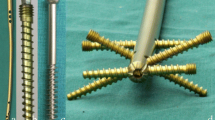Abstract:
The treatment of proximal humerus fractures is a matter of continuing scientific discussion. This study presents our results with the use of retrograde intramedullary fixation as a minimally invasive, soft tissue-preserving treatment for two-part and certain three- and four-part fractures of the proximal humerus.
Patients and Method: Between 01/1994 and 02/1998, 68 consecutive patients with 69 humeral head fractures were stabilized by retrograde intramedullary wiring. Fracture reduction was performed using a closed technique and stabilized with multiple intramedullary wires, which were inserted 2 cm above the olecranon fossa. All study patients had a minimum postoperative follow-up of 12 months.
Results: From these 57 follow-up patients 65% had excellent Neer and Constant scores. 25% showed a satisfactory, 10% an unsatisfactory or poor result.
Conclusion: Retrograde intramedullary wiring following closed indirect reduction is a minimally invasive treatment technique that preserves soft tissue and is especially useful for treating two- and minimally displaced three- and four-part proximal humerus fractures.
Similar content being viewed by others
Author information
Authors and Affiliations
Additional information
Received: June 21, 2001; revision accepted: June 10, 2002
Rights and permissions
About this article
Cite this article
Khodadadyan-Klostermann, C., Raschke, M., Steenlage, E. et al. Intramedullary Wiring of Proximal Humerus Fractures Results of a Minimally Invasive Treatment Concept. Eur J Trauma 28, 234–241 (2002). https://doi.org/10.1007/s00068-002-1154-7
Issue Date:
DOI: https://doi.org/10.1007/s00068-002-1154-7




